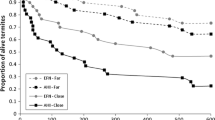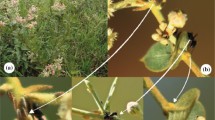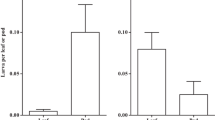Abstract
Despite the general belief that the interaction between extrafloral nectaries (EFNs) and ants is mutualistic, the defensive function of EFNs has been poorly documented in South American savannas. In this article, we evaluate the potential impact of EFNs (benefits and costs) on two species of plants from the dry areas of Central Brazil, Anemopaegma album and Anemopaegma scabriusculum (Bignoniaceae). In particular, we characterize the composition of substances secreted by the EFNs, test whether EFNs attract ants, and whether ants actually present a defensive role, leading to reduced herbivory and increased plant fitness. Histochemical analyses indicated that EFNs from both species of Anemopaegma secrete an exudate that is composed of sugars, and potentially lipids and proteins. Furthermore, EFNs from both species were shown to present a significant role in ant attraction. However, contrary to common expectations, ants were not found to protect plants against herbivore attack. No effect was found between ant visitation and flower or fruit production in A. album, while the presence of ants led to a significant decrease in flower production in A. scabriusculum. These results suggest that EFNs might present a similar cost and benefit in A. album, and a higher cost than benefit in A. scabriusculum. Since the ancestor of Anemopaegma occupied humid forests and already presented EFNs that were maintained in subsequent lineages that occupied savannas, we suggest that phylogenetic inertia might explain the presence of EFNs in the species of Anemopaegma in which EFNs lack a defensive function.





Similar content being viewed by others
References
Alonso LE (1998) Spatial and temporal variation in the ant occupants of a facultative ant-plant. Biotropica 30:201–213
Beattie AJ (1985) Plant protection by direct interaction. The evolutionary ecology of ant-plant mutualisms. Univ of Cambridge, Cambridge, pp 21–53
Blomberg SP, Garland T (2002) Tempo and mode in evolution: phylogenetic inertia, adaptation and comparative methods. J Evol Biol 15:899–910
Bronstein JL (1994) Conditional outcomes in mutualistic interactions. TREE 9:214–217
Byk J, Del-Claro K (2010) Nectar- and pollen-gathering Cephalotes ants provide no protection against herbivory: a new manipulative experiment to test ant protective capabilities. Acta Ethol 13:33–38
Carroll CR, Janzen DH (1973) Ecology of foraging by ants. Annu Rev Ecol Syst 4:231–257
Chamberlain SA, Holland JN (2009) Quantitative synthesis of context dependency in ant-plant protection mutualisms. Ecology 90:2384–2392
Christianini AV, Oliveira PS (2010) Birds and ants provide complementary seed dispersal in a Neotropical savanna. J Ecol 98:573–582
Coley PD (1980) Effects of leaf age and plant life history patterns on herbivory. Nature 284:545–546
Costa AN, Vieira-Neto Vasconcelos HL, EHM Bruna EM (2008) Do herbivores exert top-down effects in Neotropical savannas? Estimates of biomass consumption by leaf-cutter ants. J Veget Sci 19:849–854
Crist TO, Macmahon JA (1992) Harvester ant foraging and shrub steppe seeds—interactions of seed resources and seed use. Ecology 73:1768–1779
Davidson DW (1997) The role of resource imbalances in the evolutionary ecology of tropical arboreal ants. Biol J Linn Soc 61:153–181
Del-Claro K, Berto V, Réu W (1996) Effect of herbivore deterrence by ants on the fruit set of an extrafloral nectary plant, Qualea multiflora (Vochysiaceae). J Trop Ecol 12:887–892
Eiten G (1972) The cerrado vegetation of Brazil. Bot Rev 38:201–341
Elias TS, Gelband H (1975) Nectar: its production and functions in trumpet creeper. Science 189:289–291
Heil M, McKey D (2003) Protective ant-plant interactions as model systems in ecological and evolutionary research. Annu Rev Ecol Evol Syst 34:425–453
Hickman JC (1974) Pollination by ants—low-energy system. Science 184:1290–1292
Janzen DH (1966) Coevolution of mutualism between ants and acacias in Central America. Evolution 20:249–275
Jones CG, Callaway RM (2007) The third party. J Veget Sci 18:771–776
Keeler KH (1985) Extrafloral nectaries on plants in communities without ants: Hawaii. Oikos 44:407–414
Kersch MF, Fonseca CR (2005) Abiotic factors and the conditional outcome of an ant-plant mutualism. Ecology 86:2117–2126
Korndorfer AP, Del-Claro K (2006) Ant defense versus induced defense in Lafoensia pacari (Lythraceae), a myrmecophilous tree of the Brazilian cerrado. Biotropica 38:786–788
Lohmann LG (2003) Phylogeny, classification, morphological diversification and biogeography of Bignonieae (Bignoniaceae). Ph.D. thesis, University of Missouri-St. Louis, St. Louis
Lohmann LG (2006) Untangling the phylogeny of Neotropical lianas (Bignonieae, Bignoniaceae). Am J Bot 93:304–318
Lohmann LG (2011) A new generic classification of Bignonieae (Bignoniaceae) based on molecular phylogenetic data and morphological synapomorphies. Ann Miss Bot Gard (in press)
Machado SR, Morelatto LPC, Sajo MG, Oliveira PS (2008) Morphological patterns of extrafloral nectaries in woody plant species of the Brazilian cerrado. Plant Biol 10:660–673
Manzaneda AJ, Rey PJ (2008) Geographic variation in seed removal of a myrmecochorous herb: influence of variation in functional guild and species composition of the disperser assemblage through spatial and temporal scales. Ecography 31:583–591
Moraes SC, Vasconcelos HL (2009) Long-term persistence of a Neotropical ant-plant population in the absence of obligate plant-ants. Ecology 90:2375–2383
Nascimento EA, Del-Claro K (2010) Ant visitation to extrafloral nectaries decreases herbivory and increases fruit set in Chamaecrista debilis (Fabaceae) in a Neotropical savanna. Flora (in press)
Ness JH (2003) Catalpa bignonioides alters extrafloral nectar production after herbivory and attracts ant bodyguards. Oecologia 134:210–218
Oliveira PS (1997) The ecological function of extrafloral nectaries: herbivore deterrence by visiting ants and reproductive output in Caryocar brasiliense (Caryocaraceae). Funct Ecol 11:323–330
Oliveira PS, Brandão CRF (1991) The ant community associated with extrafloral nectaries in the Brazilian cerrados. In: Huxley CR, Cutler DF (eds) Ant-plant interactions. Oxford University Press, Oxford, pp 198–212
Oliveira PS, Freitas AVL (2004) Ant-plant-herbivore interactions in the Neotropical cerrado savanna. Naturwissenschaften 91:557–570
Oliveira PS, Leitão-Filho HF (1987) Extrafloral nectaries—their taxonomic distribution and abundance in the woody flora of cerrado vegetation in southeast Brazil. Biotropica 19:140–148
Oliveira PS, Silva AF, Martins AB (1987) Ant foraging on extrafloral nectaries of Qualea grandiflora (Vochysiaceae) in cerrado vegetation: ants as potential antiherbivore agents. Oecologia 74:228–230
Orzack SH, Sober E (2001) Adaptation, phylogenetic inertia, and the method of controlled comparisons. In: Orzack SH, Sober E (eds) Adaptationism and optimality. Cambridge University Press, Cambridge, pp 45–63
Pirani JR, Mello-Silva R, Giulietti AM (2003) Flora de Grão-Mogol, Minas Gerais, Brasil. Boletim de Botânica da Universidade de São Paulo 21:1–24
Ratter JA, Ribeiro JF, Bridgewater S (1997) The Brazilian cerrado vegetation and threats to its biodiversity. Ann Bot 80:223–230
Rico-Gray V, Oliveira PS (2007) The ecology and evolution of ant-plant interactions. University of Chicago Press, Chicago
Rosumek FB, Silveira FAO, Neves FS, Barbosa NPU, Diniz L, Oki Y, Pezzini F, Fernandes GW, Cornelissem T (2009) Ants on plants: a meta-analysis of the role of ants as plant biotic defenses. Oecologia 160:537–549
Stephenson AG (1982) The role of extrafloral nectaries of Catalpa speciosa in limiting herbivory and increasing fruit production. Ecology 63:663–669
Tempel AS (1983) Bracken fern (Pteridium aquilinum) and nectar-feeding ants: a nonmutualistic interaction. Ecology 64:1411–1422
Thompson JN (1999) Specific hypotheses on the geographic mosaic of coevolution. Am Nat (suppl.) 153:S1–S14
Thompson JN (2005) The geographic mosaic of coevolution. Univ of Chicago Press, Chicago
Acknowledgments
This article is part of the doctoral thesis of A. Nogueira. Funding came from the Fundação de Amparo à Pesquisa do Estado de São Paulo (FAPESP 2007/55433-8 and Grant 2007/54917-1), and logistic support from IB-USP, IB-UNESP, IEF-MG (Gerência de Projetos e Pesquisas, Diretoria de Biodiversidade), and the State Park of Grão Mogol-MG. We are gratefully to all the assistance provided during field-work, especially to Patrícia Falcão Bueno. We thank R. Feitosa for the identification of ants and L. Borowiec (Coleoptera), U. R. Martins (Coleoptera), and F. Domenico (Orthoptera) for the identification of herbivores. We also thank to Paul Fine, Fabrício Baccaro, Miriam Kaehler, Pedro J. Rey, and one anonymous reviewer for fruitful discussions and comments on this article.
Author information
Authors and Affiliations
Corresponding authors
Electronic supplementary material
Below is the link to the electronic supplementary material.
Rights and permissions
About this article
Cite this article
Nogueira, A., Guimarães, E., Machado, S.R. et al. Do extrafloral nectaries present a defensive role against herbivores in two species of the family Bignoniaceae in a Neotropical savannas?. Plant Ecol 213, 289–301 (2012). https://doi.org/10.1007/s11258-011-9974-3
Received:
Accepted:
Published:
Issue Date:
DOI: https://doi.org/10.1007/s11258-011-9974-3




